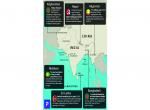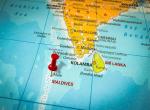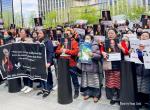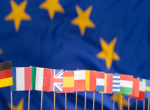It is much too early to make out straight away what the well-predicted election of Ebrahim Raisi, the incumbent Chief of Iranian Judiciary, to the Presidency of Islamic Republic of Iran is likely to bode for Iran and the world. Since his election to the office, the President-elect has steered clear of the kind of occasionally undiplomatic observations that have characterised him so far. He has averred to stay committed to the JCPOA deal that the outgoing Rouhani administration is working on reviving in Geneva, but has also indicated that he won’t stand by any freshly negotiated proviso that might compromise “Iran’s national interests.” With the shape and character of his incoming administration yet to become clear beyond the feverish speculations that have been doing the rounds for the last two weeks, we have only the president-elect’s past record, observations and his putative allies to conjecture what the character of the incoming administration is likely to be.
Sayyid Ebrahim Raisolsadati, better known as Ebrahim Raisi, comes from a clerical family of the pilgrimage-city of Mashhad. He went for his clerical studies at a Qom seminary, where he turned out to be pretty undistinguished in his studies. However, presumably on account of being a direct student of Morteza Motahhari (one of the most favourite disciples of Ayatollah Khomeini), Raisi became a part of the revolutionary clergy who served to climb on the bandwagon the Islamic Revolution of 1979, and became associated with the numerous revolutionary tribunals that had begun to dispense a rough-and-ready “revolutionary justice” in the heady days of 1979-80. In 1981, he was appointed formally as a prosecutor for Karaj and then the province of Hamadan, and then promoted in 1985 as the Deputy Prosecutor of Tehran. In that capacity, he is believed to have been involved with the execution of left-wing and liberal dissidents (numbering between 2,800- 3,000 according to one estimate, and 30,000 according to others) – although Raisi has neither been officially acknowledged to have done this, nor has owned up to it.
In 1989, as ‘Ali Khamenei was elevated to his present office of the Rahbar (Supreme Leader), Raisi was appointed the Chief Prosecutor for Tehran. From 2004-2014, he served as the Deputy Chief Justice of Iran, whereupon he was appointed the Attorney General (2014-16), which he left to become the chairman of the phenomenally wealthy economic foundation (Bonyad), the Astan-e Qods Rezavi. In 2019, Khamenei appointed him to the position of the Chief Justice of the Islamic Republic (a position that he holds as of date) and was also elected the First Deputy Chairman of the Majlis-e Khobregan (Assembly of Experts), a body that would choose the successor to ‘Ali Khamenei when the time comes.
Despite holding such apparently impressive credentials as a functionary of the judiciary of the Islamic Republic, Raisi’s actual credentials as a jurist are somewhat compromised.1 His relentless rise in the judicial hierarchy of the Islamic Republic, however, clearly shows that he is extremely well connected within the networks of power in Iran, and is known to enjoy an especially close relationship with Khamenei. His track record in the judiciary has been that of a die-hard revolutionary, steadfastly opposed to the reform-agenda of former Presidents Rafsanjani, Khatami and the incumbent Rouhani, whose associates have been routinely prosecuted by Raisi and his associates in different capacities and periodically disbarred from public life. His association with the Astan-e Qods Rezavi has also brought him in direct contact with the other bastion of hardline conservatives in the Iranian body-politic – the network of economic organisations associated with the Sepah-e Pasdaran-e Enqelab-e Islami (the Islamic Republic Guards Corps, i.e. IRGC), who are deeply embedded with the various Bonyad-ha (economic foundations heavily funded by the Iranian state, running a host of companies ranging from construction to mining, multi-speciality hospitals to carpet factories). This implies the President-elect’s close association with the social coalition that is the mainstay of the Osulgiran (Principlists) front, the most conservative hardliners of the country who currently dominate the Majlis (Parliament) and the deep state in the Islamic Republic.
Raisi has had precious little to say by way of an economic agenda, beyond taking the stance of an anti-corruption zealot – a short-hand for being critical of both Reformists and the administration of Ahmedinejad. However, given the social coalition that seems to have propelled him to power, and his casual observations on the reform agenda in the past, Raisi does not appear to be a votary of the integration of the Iranian economy with the larger global order, especially if it involves closer entanglement with the Western world. In response to Trump’s policy of Maximum Pressure, Raisi has spoken in favour of moqawwamat-e beshtareen (maximum resistance) which involves the building up of Iqtisad-e Moqawwamati (Resistance Economy) – i.e. ramping up Iran’s industrial capacity, reducing oil-dependency of the country’s economy, import substitution, etc. In essence these objectives are similar to the economic agenda of Iran’s much-maligned Reformists, except that the Reformist favour private enterprise to dominate the ‘reformed’ economy, while hardliners are keener on economic outfits affiliated to the revolutionary elite (i.e. the IRGC, the Basiji reservists, etc) to be the main driving force and principal beneficiaries.
The names of potential members of Raisi’s cabinet that are now being speculated in the circles of power in Tehran – people like the former Basiji Ali Reza Zakani (who pulled out of the Presidential race in favour of Raisi), Mahmoud Nabavian (hardline member of Majlis) – are known to be supportive of such postures. Social and political reform, and more importantly structural reform of the Iranian economy that the reformists had been working towards since the end of the Iran-Iraq war, are unlikely to be pursued by the incoming administration.
The outgoing Rouhani administration is trying its best to reinstate the JCPOA, and have the USA remove the sanctions regime that has pushed Tehran to the wall since 2018. Raisi and the social and political forces (including Ali Khamenei) within the Iranian deep state that seem to support him were not particularly in favour of the Islamic Republic abandoning the nuclear option altogether. Having enriched uranium to over 60%, Iran is closer to weaponisation of its nuclear capability than ever before or since the JCPOA was signed. Yet, Raisi has come on record to say he will go by the JCPOA (provided no fresh provisions are added), largely because Tehran badly needs to have the sanctions regime ended. Unlike Rouhani and the reformists, though, the Raisi administration is not likely to recalibrate the Iranian economy with the western world anymore – they need sanctions to end in order to be able to deal with the non-western world (in particular Russia and China, inter alia) with relative ease.
This ease of doing business with the outer world is essential to Iran’s economy that has stagnated (and for a period even contracted) in course of the last decade, aggravating the economic conditions of the rural and urban poor and middle classes alike, and has failed to generate economic opportunities for a growing population. Unless Iran is able to trade with the outside world, its resistance economy may not collapse overnight, but the Islamic Republic would come under tremendous strain, which might even jeopardise its stability. The incoming administration is thus likely to welcome the reinstatement of the JCPOA in order to reap its economic benefits by opening Iran to the global economy, but ideally keeping the West out of the country. Its posture towards its neighbours is likely to continue to be conciliatory as in the past several months, but only if Riyadh and Abu Dhabi reciprocate such a posture – prolonged instability in the neighbourhood is not in Tehran’s interest now that the US is seen to be determined to pull out of the region.
As far as can be made out, neither Raisi nor his putative allies have any definite position on India. The new administration, however, is likely to continue to cosy up to Beijing, in pursuit of the huge economic deal Tehran concluded early this year, to the tune of $400 billion over a 25-year period. The deal enjoyed the support of a large section of both the Reformists as well as the conservative hardliners. Rouhani entered that agreement as a fail-safe against continued US sanctions; hardliners such as Raisi support it to preclude any dependence on the west in the event of revival of the JCPOA. However, there are people even within the hardliner deep state of Iran who are uncomfortable with any one power gaining undue leverage, even China. They are likely to be keen that Beijing is not the single most important economic player in the country, and would welcome the prospects of any other power swinging in as either a major investor and/or trading partner or buyer of its energy exports, or both – as long as it is not from the West. India thus has a good opportunity beckoning to go back into Iran.
However, the asking price for re-entry is likely to be higher this time than in the past. Some segments in the corridors of power in Tehran think that New Delhi cut its losses too readily when the sanctions regime was put in place in 2010 and then again 2018. India used to be one of the most important destinations for Iranian oil exports and a major source for the refining of crude oil for Iran till 2013, when New Delhi (Reliance in particular) finally pulled out. China (Sinopec and CNPC), however, hung on. Since then Tehran has set up a number of refineries of its own, and is unlikely to depend on India the same way that it previously used to for refining crude for the Iranian market. Tehran might even ask New Delhi to prove its seriousness about doing business in Iran in the future, particularly if the sanctions regime were to remains in place or come back eventually. Such a signal can easily be provided through the suggestion for the creation of a Special Purpose Vehicle (SPV, the kind the EU has been working on the last few years) for facilitation of banking, insurance and other purposes that are particularly affected by the sanctions regime.
New Delhi would be well advised to sound and act serious in any negotiations that may come its way, and stay prepared to work with companies affiliated to the deep state in Iran, i.e. affiliated with the IRGC/Basij militia. India might even be asked to associate with Chinese partners in existing projects (such as Chabahar, Deloram-Zaranj railway link) or new ones in connection with the kind of energy and transportation infrastructure projects that may come our way. These are unlikely to be wily bargaining tactics – so they should be considered carefully in the event such propositions are made. If New Delhi can stay the course, it might find Iran much more willing to accommodate its “old friend” than it may appear.
Admittedly, this kind of crystal ball gazing is not particularly substantive, reliant as it is on electronic and media whispers emanating out of Iran. The direction and orientation of the government would depend largely on the cabinet that is finally chosen, whether it has pragmatist conservatives (like allies of Larijani) or those affiliated to the bazaar (Khamenei’s natural constituency at one point of time), or is it dominated entirely by ex-IRGC characters. A lot would also depend on whether Raisi is being seriously considered as the successor to Khamenei when the seriously ailing Supreme Leader passes away, or is his elevation merely meant to smoothen the path for the succession of Mujtaba Khamenei to his father’s office (as many have been arguing for quite some time) – for that would determine whether Raisi is going to have a long-term perspective or not.
Endnotes
- There is no clarity on his academic attainments as a jurist – at one point of time he used to claim to being an Ayatollah (something like a Senior Professor in the Shi‘i seminarian hierarchy), but upon being challenged began to call himself a Hojjat ul-Islam (something like an Associate Professor) instead.
(The paper is the author’s individual scholastic articulation. The author certifies that the article/paper is original in content, unpublished and it has not been submitted for publication/web upload elsewhere, and that the facts and figures quoted are duly referenced, as needed, and are believed to be correct). (The paper does not necessarily represent the organisational stance... More >>
Image Source: https://images.hindustantimes.com/img/2021/06/19/550x309/2021-06-19T173738Z_1_LYNXNPEH5I0AC_RTROPTP_3_IRAN-ELECTION_1624127588490_1624127601372.JPG










Post new comment